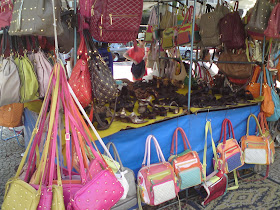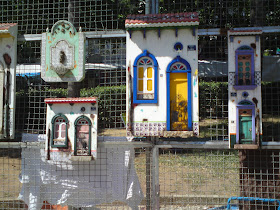
In this episode of the
ArtTactic Podcast, we're joined by
Adriano Picinati Di Torcello, Senior Manager at Deloitte Luxembourg. Adriano begins by sharing with us Deloitte's latest initiatives pertaining to Art and Finance. Meanwhile, have wealth managers started to embrace the concept of art as a financial asset? Adriano tells us to what extent they have incorporated art within their services for their clients. Adriano then looks into the future and predicts what types of financial products and transformations to the marketplace are possible. Also, he discusses both the positive and negative aspects of speculative money returning to emerging and established art markets. Lastly, Adriano analyzes the split in the art world between having a more regulated marketplace versus the non-transparent nature that some argue can lead to superior returns for investors,
LINK: http://arttactic.com/podcast.php?id=63
>>>>>>>>>>>>>>>>>>>>>>>>>>>>>>>>>>>>>>>>>>>>>>>>>>>>>>>
Press article: When pleasure and profit go hand in handLuxembourg for Finance -
November 2009
Equity and bond funds are well known asset classes; funds investing in art and other collector items much less so. Yet the rise of art as a financial asset is a reality. Deloitte Luxembourg is convinced that these “emotional assets” or “passion investments” have a serious role to play as a new financial niche. But why invest in paintings, wine, jewelry, diamonds or musical instruments? Adriano Picinati di Torcello, Senior Manager at Deloitte Luxembourg, provides some answers.
The art market is becoming a financial commodity, thanks to two phenomena : globalisation and research. «Not so long ago, there was a perception that the art market was the reserve of the rich and the very rich. However, alongside growth in knowledge about the art market and an increase in transparency thanks to the publication of indices and information about sales being held and prices achieved at auction, we have noticed growing interest in art as a financial asset. Adriano Picinati di Torcello adds that investment funds investing in art have emerged over the last few years.
This trend is not limited to the art market but equally concerns other collector items. He adds that whereas there were some precedents in the last century, this has now become a global phenomenon with funds being set up, for instance, in the United States, England, Austria and India. In general, these funds are only open to “qualified investors”, but some are open to much smaller investors.
Paintings and wine are the categories you most often see in the portfolio of these new funds. Beside these categories, jewels, photographs, diamonds, stamps, old coins and musical instruments – notably violins – are other “collectable assets” that you come across. Some funds diversify their portfolios by investing in several categories of collector items.
Why invest in art?
According to Deloitte, there are several reasons why a client might invest in art and collector items: the potential performance generated by the inefficiency of these markets, protection against the risk of inflation, reduction of risk because of its low correlation with other financial assets, a reserve price at sale and the possibility of earning extra revenue by rending out the work or of participating in events such as exhibitions and meetings of experts, hence adding aesthetic pleasure. “Many investors who unfortunately lost a lot of money in the financial crisis, investing in products they did not understand, are turning back to things that are closer to their heart and which at the same time offer protection and a return on investment. Picinati di Torcello adds that you do not have to be an expert in art or wine, for example, to invest in this type of fund. “However, you must be confident that the people who are proposing such products are experts and have the competence necessary to ensure an appropriate selection of works, verification of their authenticity, due diligence on their origin, and so on, in order to avoid certain risks that are intrinsic to the sector.”
Amateur art collector or not, all investors are looking for an acceptable return on investment. According to academic studies, the long term performance of works of art is probably around 6%, and in a period of economic boom can reach 10-12% without taking inflation into consideration. But how can an art fund generate returns? Picinati di Torcello lists several potential strategies. These include "profiting from market inefficiencies in order to buy and sell advantageously, also by finding interesting opportunities when objects are sold in the event of a death or a divorce, for example, and by anticipating trends. Insider dealing is not a crime in the art market.”
Luxembourg as a centre of competence
London and New York are the two big capitals in the art market, but they are being given a run for their money by the Asian markets. According to Picinati di Torcello, England is probably more engaged in the sector because of the presence side by side of experts in art and finance. However, it is quite possible for the fund to be domiciled elsewhere, such as in Luxembourg. “The idea we are trying to promote is that Luxembourg, thanks to the SIF (Special Investment Fund), has a role to play attracting promoters and fund managers to domicile their schemes in Luxembourg. There are funds already established in Luxembourg that invest in collector items, such as wine, violins and art. The SIF vehicle is a structure that is very flexible and perfectly adapted to this purpose.” He does not think that the lack of experts is a competitive handicap for the Grand Duchy. “Just as in the equity and bond sectors, we do not necessarily have the specialists, like fund managers, based locally. On the other hand, for knowledge about anything to do with domiciliation, administration or distribution of the product, this can be found in Luxembourg.”
Investment funds: an art in itself
It is undeniable that art and other collector items, as a new asset class, have some solid reasons to attract high net worth investors. Picinati di Torcello is convinced that the Luxembourg financial centre holds all the necessary cards to become a competitive player in the field. With this in mind, Deloitte recently organised two conferences on the rising importance of the art market and other collector items as a new financial asset. The second of these took place in October 2009 in London, in cooperation with the University of Maastricht, twelve months after the first conference organised in Luxembourg at the Philharmonie. Given the positive impact of these events, a third event will be organised in October 2010 in Paris. The formula will be similar to that held in 2009: there will be an academic stream in which specialists discuss the latest academic research and papers in the field, and a part that is open to the public. In London, fund managers came to talk about their experiences, as did specialists from international auction houses, insurance companies and consultants specialising in the field. In order to inform the public about this evolving market sector, Deloitte has created a web page www.deloitte-artandfinance.com where more information on these conferences is available.
Source: www.lff.lu









































